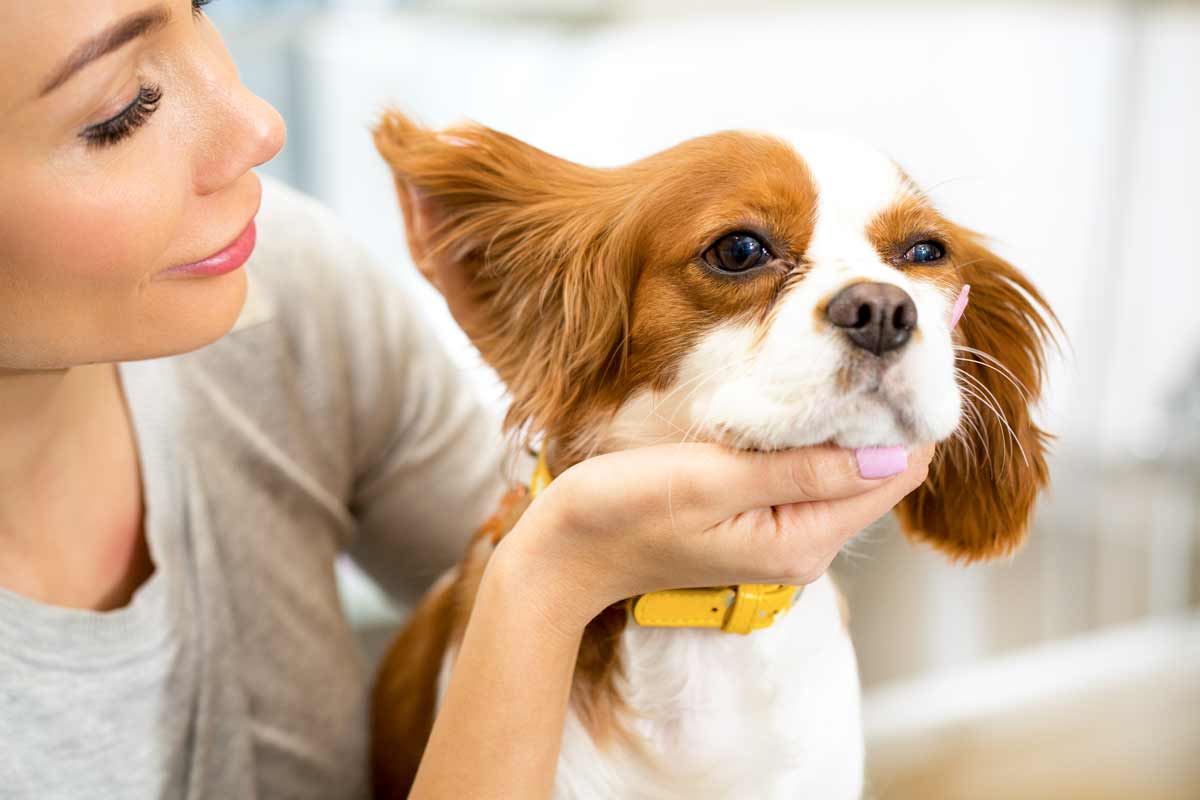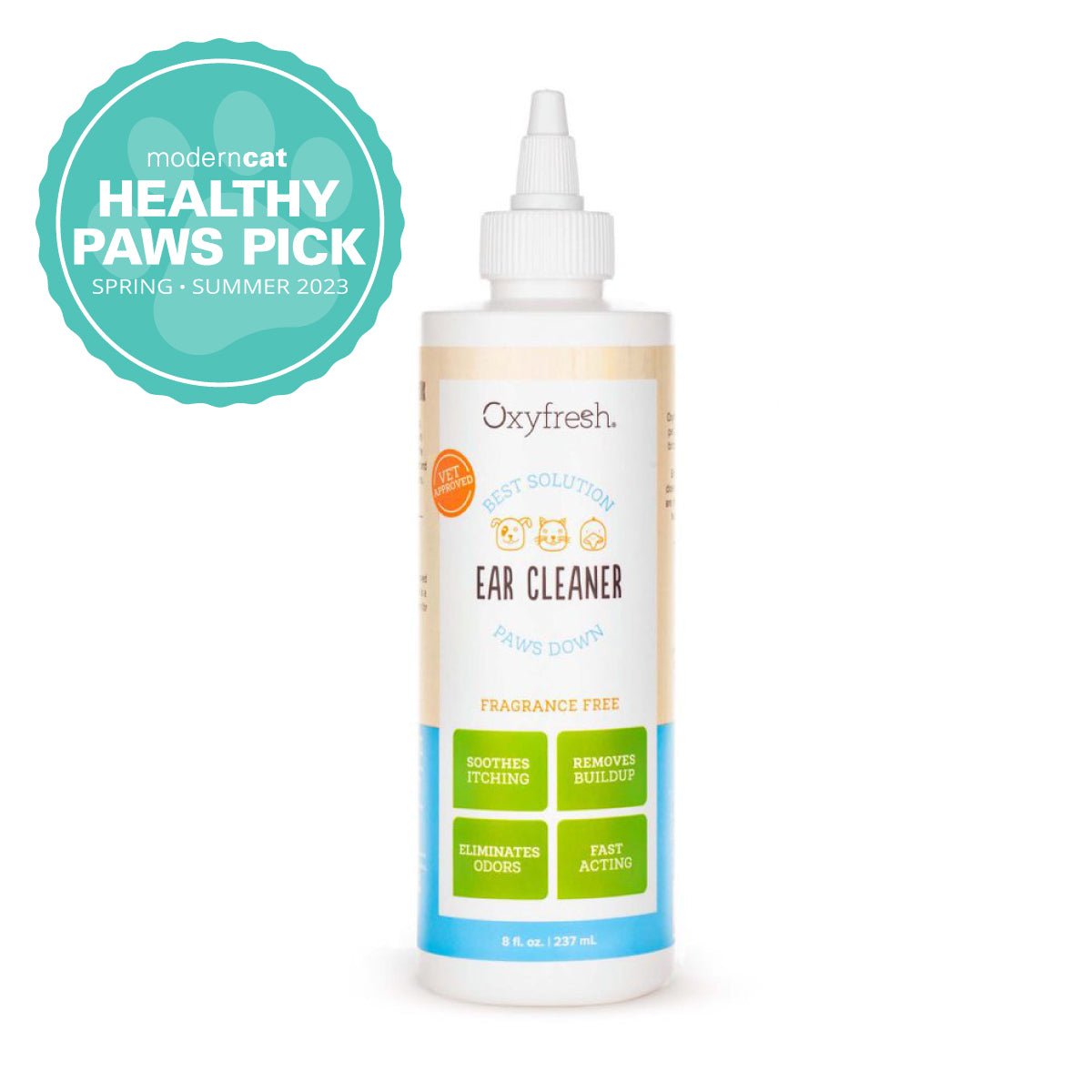Dogs instinctually try to hide pain, but don’t let their brave nature fool you: if your dog’s ears are swollen, they’re in need of some major TLC, and fast!
From dog ear hematomas to allergies, there are several causes of swollen dog ears. Get the scoop on the 5 main things it could be and discover what you can do at home to keep their ears healthy.
1. Inner or Outer Ear Infection

According to the American Kennel Club, 20% of dogs experience some form of ear infection or disease. Any dog can get an ear infection, but those with long floppy ears, allergies, and those who spend lots of time in the water (hello, sprinkler!) are more predisposed to dog ear infections, which can be either viral or bacterial in nature (or both).
Dog breeds prone to ear infections
- Shar Peis
- Beagles
- Cocker Spaniels
- Basset Hounds
- Golden Retrievers
- Labradoodles
- Border Collies
- Cockapoos
- Bulldogs
Approximately 95% of all dog ear infections are of the external ear. These infections are usually mild and will clear up in a few weeks after a visit to the veterinarian. DO visit the vet, as untreated ear infections can lead to severe pain and spread to the inner part of the ear. An ear infection of the inner ear often requires surgery and is much harder to treat. If you notice signs of a dog ear infection, never wait it out. Do your furry bestie a favor and make an appointment right away.
Signs of a dog ear infection
- Dog’s ear is swollen
- Head shaking
- Excessive scratching of the ear
- Dark discharge/wax
- Dog’s ears stink
- Redness of ear canal
- Crusting or scabs in the ear
- Dog doesn’t want to be touched around the ears
- Dog is off balance
2. Ear Mites

Dog ear mites are parasites that are barely visible to the naked eye. They are very common in puppies and shelter pets, as they easily spread from pet to pet, either through direct contact or shared bedding. Outdoor cats often get ear mites, and they can spread them to dogs in the home.
Ear mites can cause a dog’s ear to swell because the mites feed on all the oils, wax, and old skin cells inside the dog’s ear, which is highly irritating.
Fortunately, ear mites are easy to spot. The debris they leave behind in a dog’s ear looks like dark brown or black coffee grounds. The debris can also take on a reddish hue when the mite debris mixes with blood in the dog’s ear due to all the scratching. (Mites cause extreme itchiness.)
It’s best to treat ear mites at the vet, but if you decide to go the OTC route, it’s important to start with clean dog ears. Otherwise, the medication will simply sit on top of the ear mite debris without getting to all the mites and their eggs. (Eww.) As you treat your pet’s ear mites, you’ll also want to be vacuuming and washing bedding on a hot water setting so your dog doesn’t get reinfected. (Oh, and don’t worry. Mites rarely spread to humans ... phew!)
3. Dog Ear Hematoma

If your dog’s ear looks swollen, it’s most likely a dog ear hematoma, also called an aural hematoma. Dog ear hematomas happen when blood vessels rupture in the earflap (pinna). As the blood accumulates, it causes the ear to swell up. Dog hematomas can be small or large, affecting one portion of the ear or the entire ear.
Aural hematomas resemble a blood blister but are not as red. Dog hematomas may look like they’re about to burst, but fortunately, they rarely do. If you feel the area where your dog’s ear is swollen, it will feel spongy or like a water balloon. It may also feel warm to the touch. Careful, though! Aural hematomas are very painful for our furry friends.
What causes dog ear hematomas?
Dog ear hematomas are caused by trauma, usually from the vigorous ear scratching or head shaking that accompanies an ear infection. Insect bites (especially those that don’t break the skin), ticks, or a foreign object (e.g. blade of grass) getting stuck in the ear can also cause irritation that leads to a dog hematoma. Dogs with floppy ears and those prone to recurrent ear infections are most likely to get an aural hematoma.
How to treat a dog hematoma
Because dog hematomas are usually caused by ear infections, it’s important to see the vet if your dog’s ear is red and swollen. The blood from smaller aural hematomas will gradually reabsorb, usually around 10 days. (Keep in mind, though, if the dog's ear isn't drained, the hematoma can scar over and give the ear a cauliflower-like appearance.)
Larger, painful aural hematomas, especially when they block the ear canal, will require vet intervention. Surgical treatment involves draining the ear of fluid, then the vet will sew in sterilized buttons (yes, buttons!) or other special gadgets to spread pressure over the ear and keep it from refilling and swelling up again. The buttons, while not the fashion statement your pooch was going for, will remain in the ear until it heals. Your pup will be sent home with medications and possibly ear bandages to keep the ear from flopping around during the healing process.
Non-surgical routes, likely involving draining the ear and injecting a steroid, are also used to treat dog ear hematomas, though they are not as effective as surgery. It’s possible for the ear to refill with blood, and if this happens, surgery may be the next step. Talk with your vet to see which option is best for you and your dog.
4. Tumor or Blockage

Tumor is a scary word for every dog parent, but thankfully, ear tumors in dogs are rare. Tumors, which are either benign or malignant (cancerous), cause excessive cell growth in the ear. The body responds aggressively to reduce this cellular activity through inflammation, which leads to swelling of the dog’s ear.
A blockage in the dog’s ear canal can interfere with proper ear wax flow and lubrication of the inner ear, leading to microbes multiplying out of control into an ear infection. A common symptom of a dog ear infection is swelling.
5. Allergies

Dogs can get allergies just like people, which can lead to swelling of the ear. That’s because 50% of dogs with skin allergies will get an ear infection. Allergies are caused by things like fleabites, environmental allergens (dust, pollen, mold, grasses, etc.), or food allergies/sensitivities.
Flea allergies will make dogs very itchy, especially at the base of their tails. You may notice their skin becomes red and scabbed.
Food allergies also cause itchiness, primarily of the ears and paws. They will likely show gastrointestinal upset too (vomiting/diarrhea) and an unhealthy-looking coat. Keep in mind that true food allergies are rare in dogs. Rather than an allergy, it’s most likely a sensitivity. Common food sensitivities in dogs include beef, chicken, eggs, corn, wheat, soy and milk. Food allergies/intolerances are often diagnosed using an elimination diet.
If your dog’s allergy symptoms, including dog ear swelling, only occur during certain times of the year, the most likely cause is an environmental allergen, which is the most common allergy in pets. Dogs who are more pre-disposed include terriers, boxers, and retrievers.
There are many ways to help your dog with environmental allergies. Like those doormats say, Wipe Your Paws (or rather your dog’s) after being outdoors to remove as many allergens as possible. You can also wash their face after playing outdoors. To keep allergens off your pet, wash their bedding once a week. Bathing your pup on a regular basis with a gentle moisturizing dog shampoo is also a must.
Other strategies include watering and mowing your yard often to reduce pollen levels, keeping your dog out of tall grass, using an air purifier in your home, changing the furnace filter regularly, and, of course, talking to your vet about allergy medications or supplements for your pup that could help if your tactics at home aren’t working.
Signs of allergies in dogs
- Itchiness (ears and all over)
- Runny eyes
- Excessive licking
- Sneezing
- Hives
- Swelling of ears, eyelids or lips
- Red, inflamed skin
- Vomiting or diarrhea
- Chronic ear infections
Clean Dog Ears Are Your #1 Defense

With ear infections and dog hematomas being the prime culprits behind ear swelling in dogs, your #1 defense is to keep your dog’s ears clean.
Excess wax can reduce air flow into the ear canal and lead to dirt and debris getting stuck inside, encouraging harmful bacteria growth. This can easily lead to the start of an ear infection, which is why clean dog ears are so important.
How often to clean dog ears will depend on the breed of your dog and how much wax they tend to produce. A small amount of pale-yellow or light brown wax is normal and healthy, so if there isn’t an excess of wax or a strong odor to your pet’s ears, just leave their ears alone. Overcleaning dog ears can cause irritation and disrupt the pH of the ear, ironically leading to an ear infection.
What to use (and not use) to clean dog ears

If your dog has been scratching at their dirty ears to relieve the irritation, they may have red scratches inside. Using alcohol-based dog ear cleaners or homemade vinegar solutions will sting your dog’s delicate ears and scare them, leading to a not-so-pleasant ear cleaning experience for both of you. Hydrogen peroxide is a double whammy: it stings AND bubbles rapidly, which can really freak dogs out! Fragrance is another ingredient to steer clear of, as it can cause further irritation and swelling of a dog’s ear.
For a gentle, soothing ear cleaning experience every time, loyal dog lovers, groomers, and veterinarians count on Oxyfresh Pet Ear Cleaner. This fast-acting ear cleanser is 100% free of burning alcohol, bubbling peroxides, and irritating parabens and fragrances.
Only Oxyfresh Pet Ear Cleaner uses the non-toxic power of Oxygene® to get dog ears clean and fresh. Oxygene® tackles ear odors and bacteria right at the microbial source, giving dogs instant soothing relief from itching and irritation. And all that stubborn gunk and wax inside their ears? Oh yeah ... it comes right out!
Get your dog grinning from ear to ear with Oxyfresh Pet Ear Cleaner

- Fast-acting itch relief
- Defends against ear infections
- Easily removes stubborn wax & ear mite debris
- Freshens & cleans dog ears with proprietary Oxygene®
- Hypoallergic with no burning alcohol, irritating parabens or fragrance
Remember: while clean dog ears are a great defense against ear infections and dog hematomas, if your dog is actively dealing with ear problems, play it safe and make an appointment with the veterinarian. Leaving ear problems alone, hoping they’ll go away on their own, can prolong your pet’s misery. And just look at your pup’s face ... we do not want that!






